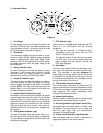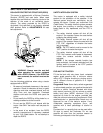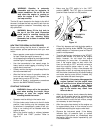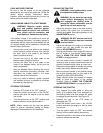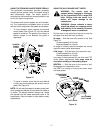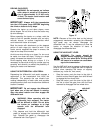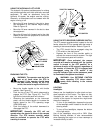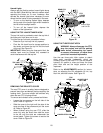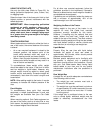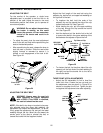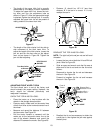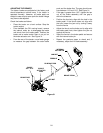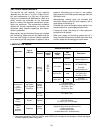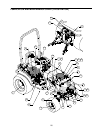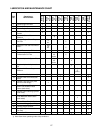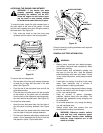21
USING THE HITCH PLATE
Use only the hitch plate (Refer to Figure 23), for
towing pull-behind equipment (carts, trailers, etc.)
or dragging loads.
Raise the lower links of the three point hitch to their
highest position to prevent interference with the
towed equipment.
IMPORTANT: When transporting pull-behind
equipment on public roadways, always use a
safety chain to supplement the connection
between the tractor and towed equipment. The
safety chain must have a strength rating equal
to or greater than the gross weight of the equip-
ment being towed.
TRACTOR WEIGHTING
When implements are installed on either the front or
rear of the tractor, the normal balance of the tractor
is altered.
• As a rear mounted implement is raised to the
transport position, the balance point of the
tractor shifts rearward, which may result in a
loss of steering control and tractor stability.
• When a front mounted implement is raised, the
balance point shifts forward and may result in a
loss of traction and stability.
To counterbalance these weight shifts, weight
should be added to the tractor in the form of either
cast iron weights or liquid ballast. However, only
enough weight should be added to obtain good
traction, control, and stability. Excessive weight will
unnecessarily load down the tractor’s engine and
transmission.
NOTE: When adding weight to the tractor, it may be
necessary to increase the inflation pressure in the
tires.
Front Weights
To counterbalance three point hitch mounted
equipment, a weight bracket/bumper kit and cast
iron weights are available from your Cub Cadet
dealer.
When mounting optional Cub Cadet equipment on
the rear of the tractor, such as a rotary tiller or rear
finish mower, the weight bracket and a minimum of
four suitcase weights should be used.
For all other rear mounted equipment, follow the
guidelines provided in the implement’s Operator’s
Manual to determine how much weight is needed to
counterbalance the equipment.
If guidelines are not available, ballast the tractor so
that a minimum of approximately 40% of the
machine weight is on the front wheels.
Weighting the Rear of the Tractor
Adding weight to the rear of the tractor is not
required for most Cub Cadet front mounted
equipment currently available for this tractor.
However, if installing only the optional front end
loader (without the back hoe), weight must be
added to the rear of the tractor. The most common
methods of adding weight are filling the rear wheels
with liquid ballast (usually a calcium chloride and
water solution) or mounting a rear weight box.
Liquid Ballast
Properly filling the rear tires with liquid ballast
increases the weight of each rear wheel to
approximately 200 pounds, which should provide
adequate counterbalance.
Because special equipment and a familiarity with
the practice is required, only a qualified tire
technician should perform this procedure. Consult
with your Cub Cadet dealer about having liquid
ballast added to your tires, and for any special
maintenance instructions after the procedure is
performed.
Rear Weight Box
A weight box will provide adequate counterbalance
if the following criteria is met:
• The weight box and contents must total a
minimum of 200 pounds.
• The weight box must be positioned a minimum
of approximately 20 inches rearward of the rear
axle, and be carried no more than 12 inches
from the ground.
If the weight box is positioned closer to the rear
axle or carried higher, additional weight must be
added to effectively counterbalance the front
loader.



